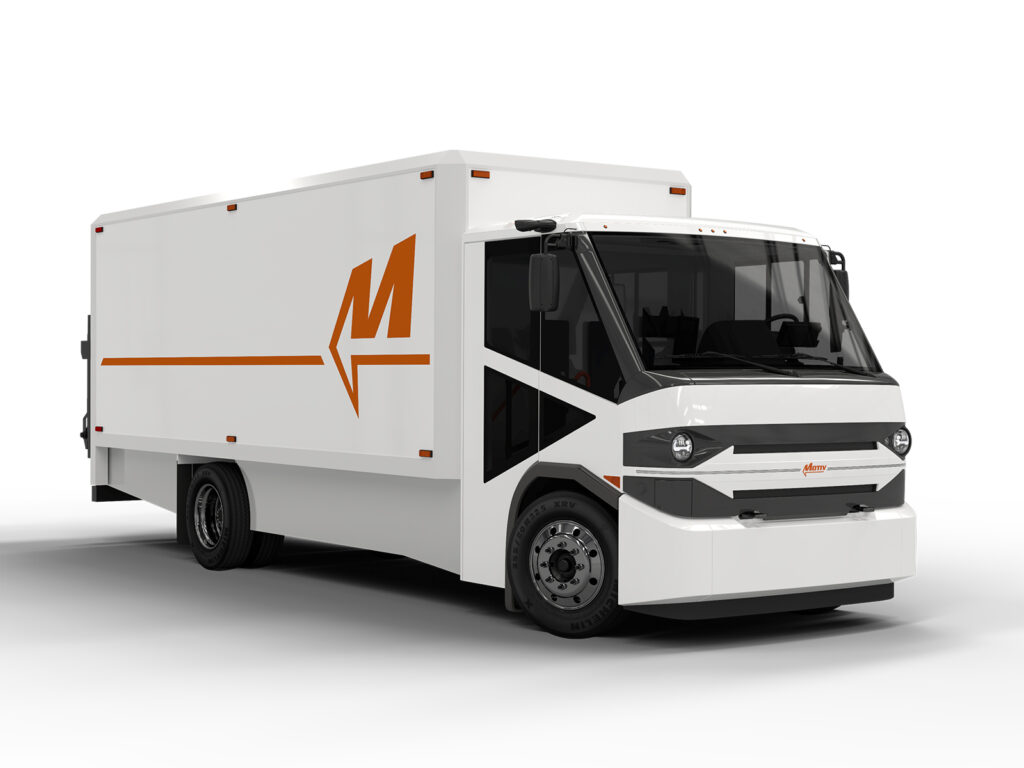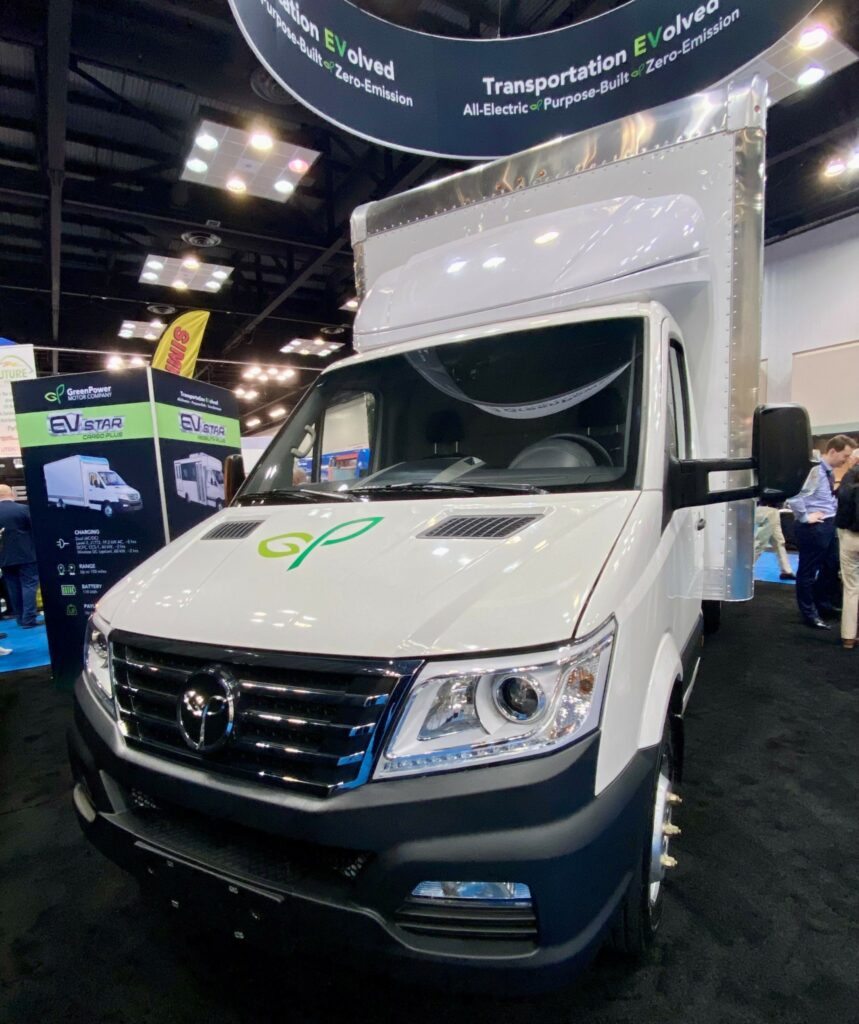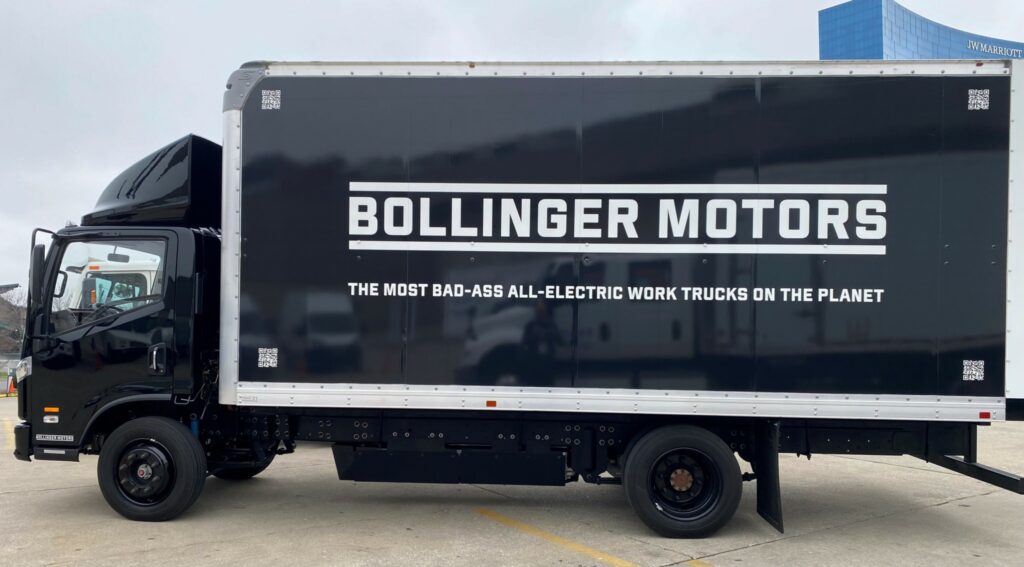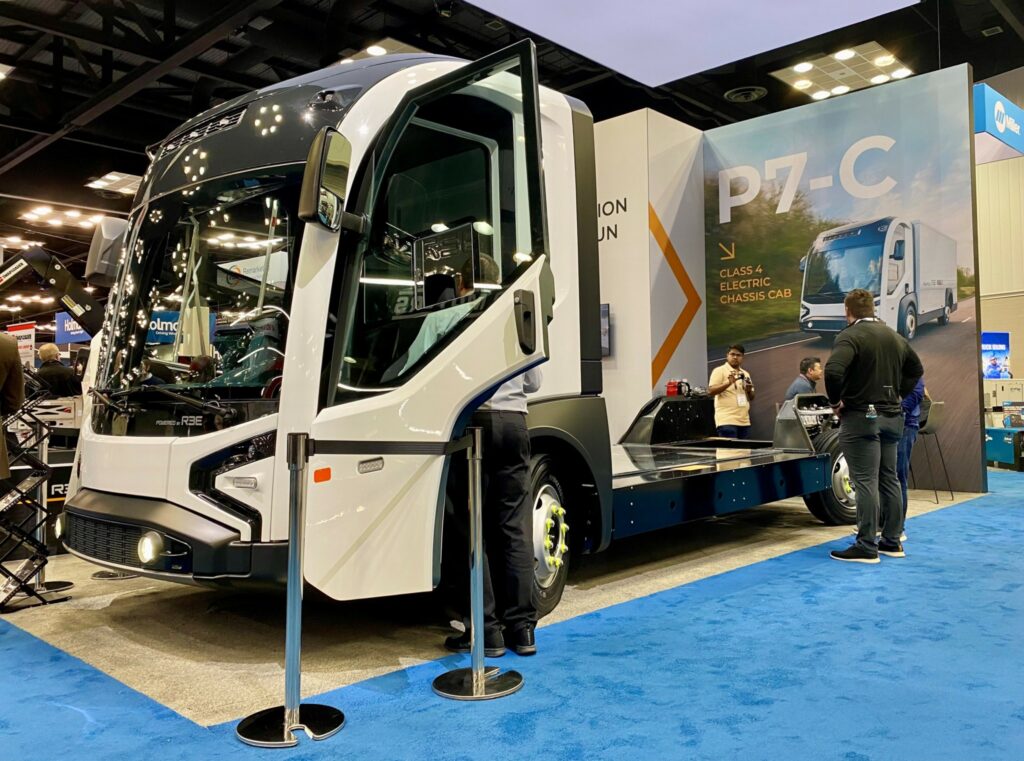Electric truck makers woo customers at Work Truck Show
While driving a Class 4 Bollinger B4 electric truck last week, acceleration was instantaneous and the cab quiet. Taking a quick spin in downtown Indianapolis, Ind., during Work Truck Week, I thought the Michigan-based company must be running the vehicle empty during the Ride & Drive event.
“Is the vehicle loaded?” I asked. “We are carrying a full load – there’s 7,000 pounds of weight in the box,” the company official sitting in the passenger seat told me. The talk of instant torque is true, even with work trucks.
Electric vehicles (EVs) attracted plenty of interest during the NTEA (The Work Truck Association) event offering clear sightlines to the path ahead while allowing attendees to touch, inspect and drive work trucks of the future.
REE Automotive’s P7-C created a buzz at Work Truck Week in Indianapolis, Ind. (Photo: Leo Barros)
There are smaller, niche EV manufacturers who have thrown their hats into the ring with the big OEMs, focused on creating new technologies and products in this fast-developing market.
TruckNews.com chatted with officials about their products and where they saw the industry heading in the next couple of years.
Motiv Power Systems
This California-headquartered company has dozens of vehicles already running in Canada. Jim Castelaz, founder, and chief revenue/technology officer, said Purolator has already deployed almost 60 step vans since last year. Canada Post is running a pilot with some vehicles.
And these EVs like working in the cold and snow. Last month, Castelaz spent eight hours riding with a Purolator driver during his shift in Quebec City. “We delivered 200 packages in about 80 stops. The driver told me, ‘The electric truck drives so much better on the snow than my old truck because we have a much smoother torque acceleration.’”
Castelaz said trucks are the easy part of the electrification journey. Fleets must give thought to charging infrastructure, time of charging and the cost. “You’ve got to get a certain amount of energy into that truck every day. If you have more hours to get that energy, it’s going to be a lot less expensive.”
 Argo medium-duty EV cab (Photo: Motiv Power Systems)
Argo medium-duty EV cab (Photo: Motiv Power Systems)
Servicing EVs and training in-house technicians is also important. “How do they keep their skills sharp if 95% of their day is conventional vehicle and 5% is EV?” Castelaz asked. He said Motiv has dedicated staff to support fleets on the training journey.
The next step in the company’s evolution is its Argo medium-duty EV cab launching later this year. The product is manufactured with structural composites that are lighter in weight and provide better insulation for in-cab warmth.
The Class 6 vehicle is less than the 26,000-lb. limit requiring a commercial driver’s licence. “We are maximizing payloads for fleets without having them to hire drivers with A/Z licences,” Castelaz said.
Powered by a lithium ion phosphate 158 kWh battery, Argo offers a chassis payload of up to 14,700 lb. with a range of 150 miles (240 km).
Catelaz added that customers are looking around and watching what others are doing. A lot of background work is also occurring. He foresees a dramatic rise in buying activity in 2025.
GreenPower Motor Company
Brendan Riley recently sold 10 of his EV Star Cargo Plus box trucks to a big-box furniture retailer in Ontario. And he has a customer at the Edmonton International Airport refueling airplanes.
GreenPower Motor Company’s president said his products are tested in, and work in, Canadian winters. And there’s extra heat in the cab along with heated seats.
The EV Star Cargo Plus has a carrying capacity of up to 5,000 lb. and a driving range of up to 150 miles (240 km), powered by a 118-kWh battery, and has dual AC and DC charging.
 GreenPower Motor Company’s EV Star Cargo Plus box truck. (Photo: Leo Barros)
GreenPower Motor Company’s EV Star Cargo Plus box truck. (Photo: Leo Barros)
Riley said the vehicle is direct drive and does not have a transmission. An electronic drive lock option is offered, which locks the driveline physically without a brake. The patented standalone parking mechanism offers an additional layer of safety during the loading and unloading process.
He added the rear differential is designed for high torque and the rear axle is created specifically for a Class 5 or 6 vehicle. “It’s a weight penalty, but it’s robust,” he said.
The company launched its GreenPower truck body built for EVs. “We understand how to fit bodies properly to EVs, where weight needs to be saved.”
Riley admitted business in the sector can be lumpy with waves and troughs. “Customers buy vehicles, try them out and buy a bunch more hopefully if things work out. You have to be prepared for that.”
GreenPower is big on driver comfort. “Remember, drivers normally don’t buy the vehicle, they just drive it for a job. I want to make sure they’re comfortable,” Riley said.
The company has also built scan codes into the screen to provide information to drivers and technicians. Cumulative discharge, battery voltage, motor status, current speed, and more are available.
“Any troubleshooting you need is there. The telematics system can be accessed from a panel in the cab on the passenger side. The system is hooked onto the cloud, accessed with a web-based application, providing vehicle location and status,” he said.
“This is not about shoehorning in old legacy technology into electrification. This truck space is unsexy, strictly vocational.”
Bollinger Motors
Bollinger’s B4 was a pleasure to drive. If not for being seated high in the cab and the box behind, it almost felt like a big car. Tight city turns were not a problem and instant acceleration must have prevented muted sighs from four-wheeler drivers behind.
Two battery packs provide 158 kWh, offering 185 miles (296 km) of range and can be charged with AC and DC power. The rear-wheel drive vehicle has a payload of 7,325 lb.
 Bollinger Motor’s B4 (Photo: Leo Barros)
Bollinger Motor’s B4 (Photo: Leo Barros)
Jim Connelly, chief revenue officer, Bollinger Motors, said fleets’ biggest pain point is hesitancy on where to go from an infrastructure perspective. “That pain point is causing a lot of them a little bit of a paralysis in their buying decisions.”
He said the sustainability project sometimes get pushed on a fleet manager who doesn’t quite know what to do with it. “Bollinger can help in that conversation and guide the individual,” Connelly said.
He added that it will be a couple of years before fleet managers get on board. The lead time on utilities and when infrastructure is in place is another factor. And carriers must be knowledgeable about grants and incentives used to subsidize purchases.
Although he’s focused on the U.S. launch of the Class 5 B5 coming next year, Connelly said the company is capitalizing and plans to move up north into Canada.
REE Automotive
And then there is the Class 4 P7-C electric chassis cab designed around four REEcorner modules, offering all-wheel-drive and regenerative braking from all four corners. X-by-wire control ensures each corner is independent with redundancies for enhanced fail-operation design.
Daniel Barel, REE Automotive’s CEO said, “This is a real 4×4!”
The P7-C looks like a luxury motor coach, with a low profile and plenty of glass in the cab. It is powered by a 400-V battery system offering a range of 150 miles (240 km), 6,000 lb. of payload and top speed of 75 mph (120 km/h).
 REE Automotive’s P7-C (Photo: Leo Barros)
REE Automotive’s P7-C (Photo: Leo Barros)
Barel follows the complete non-compete philosophy. “We are not here to compete, but will allow others to use our tech to get them to electrify faster.”
And this vehicle has just completed its second winter test in northern Sweden. “We ran it in -35C,” Barel said. “We drove it on a frozen lake and because of the x-by-wire system, you simply cannot oversteer it while it was fully loaded. This is super important for safety, especially in Canada.”
He said he has seen a lot of demand from Canada and dealers will soon be delivering vehicles to Canadian customers.
Barel said efficiency is improved by using every bit of energy in the P7-C. “Since we have four motors, it also gives us four times the regeneration.”
Barel is focused on the Classes 3 to 5 segments and is keen to scale up properly. And he’s listening to customer feedback to improve his product.
